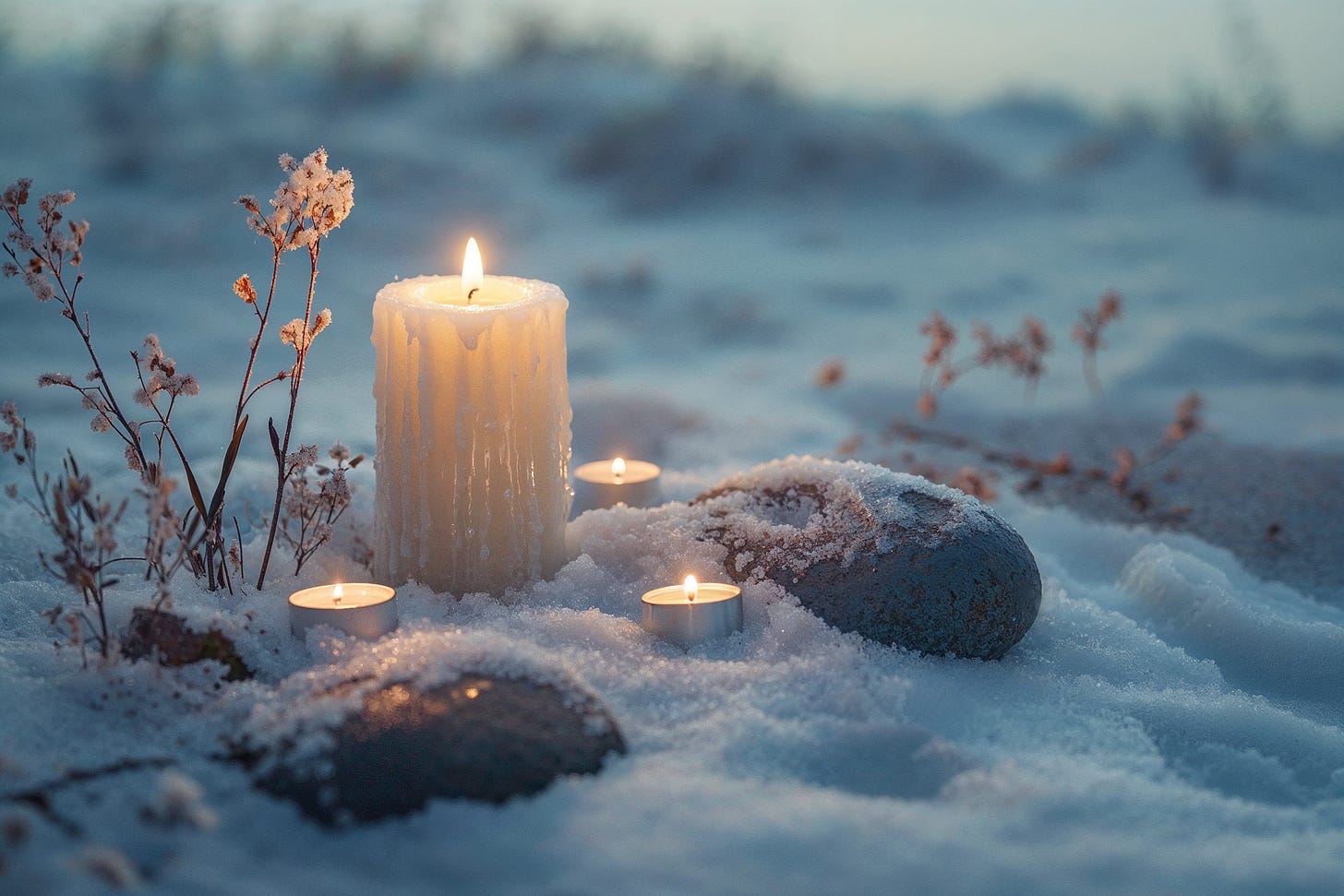There are winters that happen outside of us, and winters that happen within.
They speak the same language—quiet, slow, unhurried.
I’ve known both kinds. The frost that gathers on the windows and the frost that settles behind the ribs. Seasons when warmth feels distant and the simplest task asks for more than you have to give.
Grief moves like the weather. It arrives without warning, lingers longer than you’d expect, and teaches patience the hard way.
There’s an ache that belongs to this season. It hums beneath daily life. It lives in the body, in the hollow between heartbeats. It makes you tired in a way that sleep can’t reach.
This is the long winter of the heart.
When the light grows thin
There comes a time in grief when everything seems to slow down. The world softens at the edges. Colors fade. Mornings stretch on forever. The body begins to speak in whispers instead of shouts.
Winter has always understood what it means to stop striving. The trees know how to stand empty. The soil goes still and holds what it cannot yet grow. Every living thing withdraws to remember what sustains it.
The heart does the same.
Healing often hides inside stillness. The body asks for less movement and more warmth. Breath becomes a kind of prayer.
The world around us rarely honors that rhythm. It demands pace, purpose, positivity. But grief asks for a quieter truth. It asks for rest that is not earned.
Frost forms when the air cools enough to hold what it carries. In the same way, the heart forms its own protection. It shields what remains tender until the world feels safe again.
The ache of waiting
Grief often feels like waiting for something unnamed. Waiting for mornings that don’t feel heavy. Waiting for enough energy to cook, to call, to care. Waiting for color to seep back into life.
That waiting is a job in itself.
Some evenings, I light a candle just to remember what warmth looks like. Some mornings, I wrap myself in a blanket and breathe until the quiet feels less sharp.
Healing moves in circles. The heart opens, closes, and opens again. Every turn serves a purpose, even when it doesn’t feel that way.
Winter teaches a patience that holds space for what we can’t yet see. Beneath frozen soil, roots reach deeper. The unseen world continues to operate while everything above ground appears still.
Resting in grief is an act of courage. The mind wants progress. The soul wants rhythm. The work of winter is to keep what matters alive until new life begins again.
If these words feel like a companion in your own season of stillness, I hope you’ll subscribe to Bone & Bloom, where I write each week about grief, healing, and the sacred, strange, deeply human work of being alive.
The tenderness of dormancy
Even in deep cold, life continues. It lies hidden beneath the surface, waiting for its moment. The bulbs rest. The branches hold their shape against the wind. The world pauses without giving up.
The same quiet movement happens inside you.
The soul gathers itself slowly. It listens. It chooses what to hold. It rearranges what no longer fits. In time, the first signs of renewal begin to stir.
Light does not vanish when the days are short. It lives in small places—the hands that reach for you, the breath that steadies, the softness you offer yourself when no one is watching.
Healing does not need to prove itself. The ache that remains is a sign of how much life you’ve carried.
The long winter of the heart becomes a place of preparation. In the silence, everything rearranges itself for what will come next.
Staying with the silence
Faith lives quietly in the act of staying.
To stay through grey mornings and long nights. To stay when words fall short. To stay when the only prayer left is breath.
There is meaning in that kind of suffering. It isn’t about reasons or outcomes. It’s the kind of trust that grows in darkness, the kind that understands stillness as its own kind of movement.
Some nights, I light a candle and speak the names of those I’ve lost. The flame flickers, and memory fills the room. On other nights, I sit in the dark and let the quiet hold me. Both moments feel like prayer.
If you find yourself in your own winter, know that this is still part of the story. Stillness has its own kind of pulse. The heart is working, even when it feels suspended.
A ritual for the long winter
Each evening, as the light fades, light a single candle.
Sit beside it for a few minutes. Let the warmth touch your hands. Watch the shadows shift across the walls.
Say what feels true in that moment. Maybe it’s a word of gratitude. Maybe it’s a sigh that finally leaves the body.
Let the candle burn for as long as it feels right. Notice the small softening that happens when you stop rushing to feel better.
This practice isn’t about release or resolution. It’s a way of being with what is alive in you right now.
Grief has its own holiness. Stillness holds a quiet strength. When spring returns, it will find you different than before, shaped by all that winter taught you about love and survival.
Until then, tend the small light that remains.
Love today,
Heather 🌸
Journal prompt:
What part of you needs stillness today?
How can you offer warmth to the places inside that feel like winter?
And if you’re living through loss right now, you might find comfort in Still Here: A Digital Grief Companion—a six-week journey of reflection, ritual, and gentle guidance through the landscape of mourning.
Part guidebook, part witness, part quiet conversation with your own heart.


